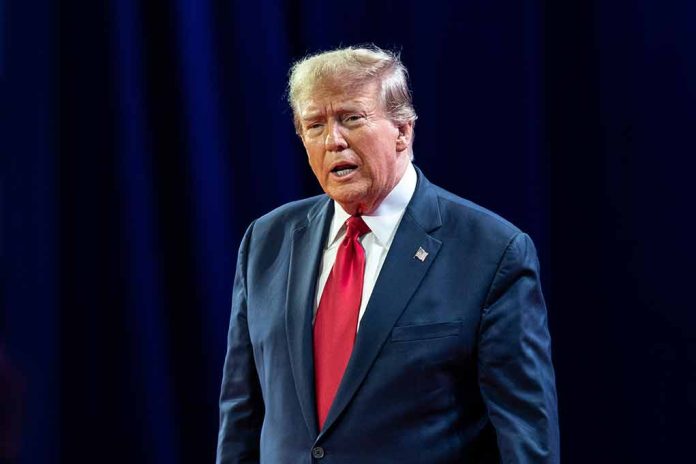
Former President Donald Trump is set to sign an executive order aimed at curbing inflation and reducing financial strain on American families through regulatory reform.
At a Glance
- Trump’s executive order targets unnecessary regulatory burdens, particularly occupational licensing requirements
- The order aims to promote economic growth, job creation, and worker mobility
- Occupational licensing affects 25-30% of jobs, up from less than 5% in the 1950s
- The initiative could particularly benefit military spouses and low-income individuals
- Estimates suggest licensing requirements cost the U.S. 2.85 million jobs and over $200 billion annually
Trump’s Executive Order: A Strategic Move Against Inflation
In a decisive action to combat rising inflation and ease the economic burden on American households, former President Donald Trump is preparing to sign an executive order focused on regulatory reform. The order, initially issued on December 14, 2020, aims to dismantle unnecessary regulatory barriers, with a particular emphasis on occupational licensing requirements that have long been criticized for impeding job creation and economic growth.
The executive order is part of Trump’s broader strategy to address inflation by targeting its underlying causes. By reducing regulatory burdens, the administration hopes to stimulate economic activity, lower consumer costs, and increase worker mobility across the United States.
The Impact of Occupational Licensing
Occupational licensing has become increasingly prevalent in the U.S. job market. According to the executive order, the percentage of jobs requiring such licenses has skyrocketed from less than 5% in the 1950s to between 25-30% today. This dramatic increase has had far-reaching consequences for the American workforce and economy.
The order highlights that licensing requirements can disproportionately harm low-income Americans and military spouses, two groups that often face unique challenges in the job market. Furthermore, blanket prohibitions on individuals with criminal records obtaining licenses can increase recidivism rates, creating additional societal and economic costs.
Although Donald Trump vows to bring U.S. prices down "very quickly," some economists say his policies could rekindle inflation. Here's what to know. https://t.co/JItSJ16U7O
— CBS Philadelphia (@CBSPhiladelphia) July 19, 2024
Economic Benefits of Regulatory Reform
The potential economic benefits of this regulatory reform are substantial. The executive order cites estimates suggesting that licensing requirements have cost the U.S. an estimated 2.85 million jobs and over $200 billion annually. By addressing these issues, the Trump administration aims to unlock significant economic potential and create new opportunities for American workers.
Key principles outlined in the order include the adoption of least restrictive criteria for occupational regulation, regular review of existing occupational regulations, and encouragement for individuals with criminal records to apply for licenses when appropriate. These measures are designed to increase economic flexibility and reduce barriers to entry across various industries.
Implementation and Oversight
To ensure the effectiveness of this initiative, the executive order mandates that federal agencies review and report on their regulations and policies to ensure alignment with these principles. Additionally, reports on opportunities to encourage occupational regulation reform are required every two years, maintaining a focus on continuous improvement and adaptation to changing economic conditions.
The order also establishes the “Governors’ Initiative on Regulatory Innovation” to advance occupational licensing reforms at the state level, recognizing the important role that state governments play in occupational regulation.
Trump’s aggressive tariff plan would likely send inflation above the Federal Reserve’s target and pressure the central bank to raise interest rates, a new model shows https://t.co/rDo6S1hvKB
— Bloomberg Economics (@economics) April 3, 2024
While the executive order presents a comprehensive approach to regulatory reform and inflation control, its long-term impact remains to be seen. Critics may argue that federal intervention in licensing practices could lead to unintended consequences or a reduction in professional standards. However, supporters of the initiative believe that by reducing unnecessary barriers to employment and economic activity, the order could play a crucial role in stimulating economic growth and providing relief to American families facing inflationary pressures.
As the implementation of this executive order unfolds, its effects on job creation, economic mobility, and inflation will be closely watched by policymakers, economists, and American workers alike. The success of this initiative could significantly shape the economic landscape and potentially influence future regulatory approaches at both the federal and state levels.
Sources
- Executive Order on Increasing Economic and Geographic Mobility
- Trump promises to stop inflation. But would his plans actually help?
- Inflation in the U.S. Economy: Causes and Policy Options
- A Report in Response to the Executive Order on Lowering Prescription Drug Costs for Americans
- Trump says he’ll end the “inflation nightmare.” Economists say Trumponomics could drive up prices.
- Trump’s Fiscal Legacy: A Comprehensive Overview of Spending, Taxes, and Deficits














